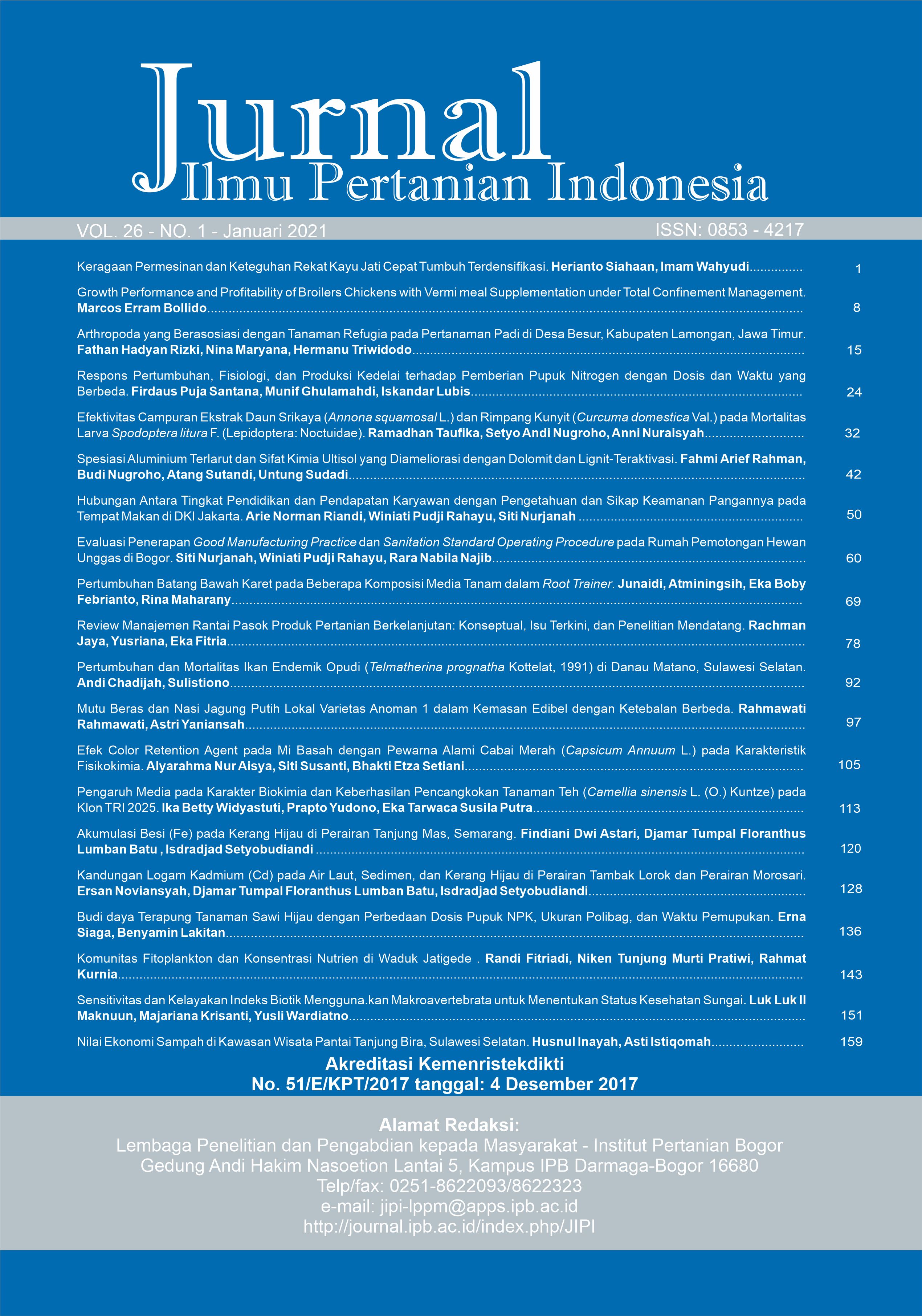Pengaruh Media pada Karakter Biokimia dan Keberhasilan Pencangkokan Tanaman Teh (Camellia sinensis L. (O.) Kuntze) pada Klon TRI 2025
Abstract
The large number of old, damaged, or dead tea plants cause the plant population per hectare to be low that eventually decreases the productivity. Propagation using the transplantation technique is used for embroidery because it has the advantage of a shorter immature plant period and higher seed size so that it can compensate for the surrounding plants but the weakness of transplantation is low success rate. This study aims to 1) determine the morphological changes of root transplantation and biochemistry on TRI 2025 clone transplantation using cocopeat, husk charcoal, and moss, 2) determine the success rate of transplantation in each medium. This research was conducted in August 2018–January 2019 at the Pagilaran production garden, PT. Pagilaran, Batang, Central Java. Field experiments were prepared using a single factor Completely Randomized Environment Design (CRD). The factors tested were the type of transplantation media, namely the media of husk charcoal, cocopeat, and moss. Observations were made on transplantation root morphology, levels of glucose, sucrose, and total sugar in the transplanted stem bark and the concentration of auxin, gibberellin, and cytokinin in the transplant roots. The data obtained were then analyzed using variance and if there was a significant difference between treatments, the Duncan multiple distance test (DMRT) was continued at the 95% confidence level. The results showed that the type of media had no significant effect on the ability to form glucose, sucrose, and total sugar in the bark. The development of root morphology of cocopeat media was seen to be the highest. The ratio of cytokinin/auxin in cocopeat was the lowest but the highest levels of cytokinin and auxin were found in moss, while cocopeat had the highest level of gibberellin. The highest transplanting success rate was found in moss medium with 58.33%, cocopeat and husk charcoal media had the same success rate, namely 41.60%.
Keywords: transplantation, biochemistry, media, success, TRI 2025
Downloads
References
Arifin S. 2014. Gerakan Penyelamatan Agribisnis Teh Nasional (GPATN). Jakarta (ID): Dewan Teh Indonesia.
Ashari S. 2006. Hortikultura Aspek Budidaya. Jakarta (ID): UI Press.
Campbell NA, Reece JB. 2002. Biology. Sixth Edition, Pearson Education. Inc. San Francisco. 802-831.
Hasriani, Kalsim DK, Sukendro A. 2013. Kajian serbuk sabut kelapa (cocopeat) sebagai media tanam.
Hua Su Y, Bo Liu Y, Sheng Zhang X. 2011. Auxin-cytokinin interaction regulates meristem development. Molecular Plant. 4(4): 616–625. https://doi.org/10.1093/mp/ssr007
Kementerian Pertanian. 2014. Perkembangan pasar teh Indonesia di pasar domestik dan pasar internasional tahun 2014. Jakarta (ID): Balai Penelitian Tanaman Industri dan Penyegar Kementerian Pertanian.
Mangoendidjojo W. 1993. Evaluasi beberapa nomer klon teh harapan di kebun pagilaran. Fakultas Pertanian Universitas Gadjah Mada. Yogyakarta (ID).
Mahfudloh A. 2008. Keberhasilan dan Pertumbuhan Stek Teh (Camellia sinensis (L) O Kuntze) Klon GMB 4 dan GMB 7 pada Beberapa Macam Media Tanam. IPB. Bogor (ID).
Miranda S. 2017. Efektivitas Serbuk sabut kelapa dan Arang Sekam dalam Mensubstitusi Media Tanam Rockwool pada Tanaman Mint (Mentha arvensis L.) secara Hidroponik dengan Sistem Sumbu. Artikel Ilmiah. Universitas Jambi.
Miyashita T, Takafumi O, Fukashi S, Hajime A, Yoichiro H. 2009. Plant regeneration with maintenance of the endosperm ploidy level by endosperm culture in lonicera caerulea var. emphyllocalyx. Plant Cell Tissue and Organ Culture (98): 291–301. https:// doi.org/10.1007/s11240-009-9562-6
Mumpuni R. 2008. Pengelolaan Pemupukan pada Tanaman Teh (CameIlia sinensis (L.) O. Kuntze) di PT. Pagilaran, Batang, Jawa Tengah. Institut Pertanian Bogor. Bogor (ID).
Prameswari ZK, Trisnowati S, Waluyo S. 2014. Pengaruh Macam Media dan Zat Pengatur Tumbuh Terhadap Keberhasilan Cangkok Sawo (Manilkara zapota (L.) van Royen) pada Musim Penghujan. Vegetalika. 3(4): 107–118.
Salisbury FB, Ross CW. 1995. Fisiologi tumbuhan jilid 2. Bandung (ID): ITB Press.
Samudin S. 2009. Pengaruh kombinasi auksin–sitokinin terhadap pertumbuhan buah naga. Media Litbang Sulteng. 2(1): 62–66.
Sulasiah A, Christiani T, Tuti L. 2015. Pengaruh pemberian jenis dan konsentrasi auksin terhadap induksi perakaran pada tunas Dendrobium sp. secara in vitro. Bioma. 11(1): 56–66. https:// doi.org/10.21009/Bioma11(2).5
Widyastuti N, Donowati T. 2007. Peranan beberapa zat pengatur tumbuh (ZPT) tanaman pada kultur in vitro. Jurnal Sains dan Teknologi Indonesia. 3(5): 55–63.
This journal is published under the terms of the Creative Commons Attribution-NonCommercial 4.0 International License. Authors who publish with this journal agree to the following terms: Authors retain copyright and grant the journal right of first publication with the work simultaneously licensed under a Creative Commons Attribution-NonCommercial 4.0 International License. Attribution — You must give appropriate credit, provide a link to the license, and indicate if changes were made. You may do so in any reasonable manner, but not in any way that suggests the licensor endorses you or your use. NonCommercial — You may not use the material for commercial purposes.























